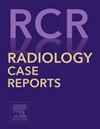Diffuse glioma with FGFR3::TACC3 gene fusion and prominent calcification: A case report
Q4 Medicine
引用次数: 0
Abstract
Diffuse gliomas with fibroblast growth factor receptor 3 (FGFR3) and transforming acidic coiled-coil containing protein 3 (TACC3) gene fusion represent a distinct molecular subtype of isocitrate dehydrogenase (IDH)-wildtype gliomas characterized by unique histopathological features. Although microcalcifications have frequently been reported in histopathological studies, their prevalence and diagnostic significance on radiological imaging remain unclear. We report a case of a 67-year-old woman who presented with a 1-year history of weakness in the left lower limb. Head CT revealed coarse and irregular calcifications in the deep white matter of the right frontal and parietal lobes. At the same time, MRI demonstrated a diffuse gliomatosis cerebri-like growth pattern with infiltration across the corpus callosum and contrast enhancement in distant areas. Histopathological examination confirmed glioblastoma, IDH-wildtype, and subsequent genetic testing revealed FGFR3::TACC3 fusion and amplification of FGFR3 gene. This case highlights the potential radiological characteristics of diffuse gliomas with FGFR3::TACC3 fusion, particularly the presence of coarse calcifications, that may serve as notable imaging features of this tumor. Further research is required to determine whether calcification is a characteristic of this glioma subtype.
弥漫性胶质瘤伴FGFR3::TACC3基因融合并显著钙化1例
具有成纤维细胞生长因子受体3 (FGFR3)和转化酸性卷曲卷曲蛋白3 (TACC3)基因融合的弥漫性胶质瘤代表了异柠檬酸脱氢酶(IDH)野生型胶质瘤的独特分子亚型,具有独特的组织病理学特征。虽然在组织病理学研究中经常报道微钙化,但其在放射影像学上的患病率和诊断意义尚不清楚。我们报告一例67岁的妇女谁提出了1年的历史,在左下肢无力。头部CT示右侧额叶和顶叶深部白质粗、不规则钙化。同时,MRI显示弥漫性脑胶质瘤样生长模式,贯穿胼胝体浸润,远端增强。组织病理学检查证实为胶质母细胞瘤,idh -野生型,随后的基因检测显示FGFR3::TACC3融合和FGFR3基因扩增。该病例强调了FGFR3::TACC3融合的弥漫性胶质瘤的潜在影像学特征,特别是粗钙化的存在,这可能是该肿瘤的重要影像学特征。钙化是否是这种胶质瘤亚型的特征还需要进一步的研究。
本文章由计算机程序翻译,如有差异,请以英文原文为准。
求助全文
约1分钟内获得全文
求助全文
来源期刊

Radiology Case Reports
Medicine-Radiology, Nuclear Medicine and Imaging
CiteScore
1.10
自引率
0.00%
发文量
1074
审稿时长
30 days
期刊介绍:
The content of this journal is exclusively case reports that feature diagnostic imaging. Categories in which case reports can be placed include the musculoskeletal system, spine, central nervous system, head and neck, cardiovascular, chest, gastrointestinal, genitourinary, multisystem, pediatric, emergency, women''s imaging, oncologic, normal variants, medical devices, foreign bodies, interventional radiology, nuclear medicine, molecular imaging, ultrasonography, imaging artifacts, forensic, anthropological, and medical-legal. Articles must be well-documented and include a review of the appropriate literature.
 求助内容:
求助内容: 应助结果提醒方式:
应助结果提醒方式:


